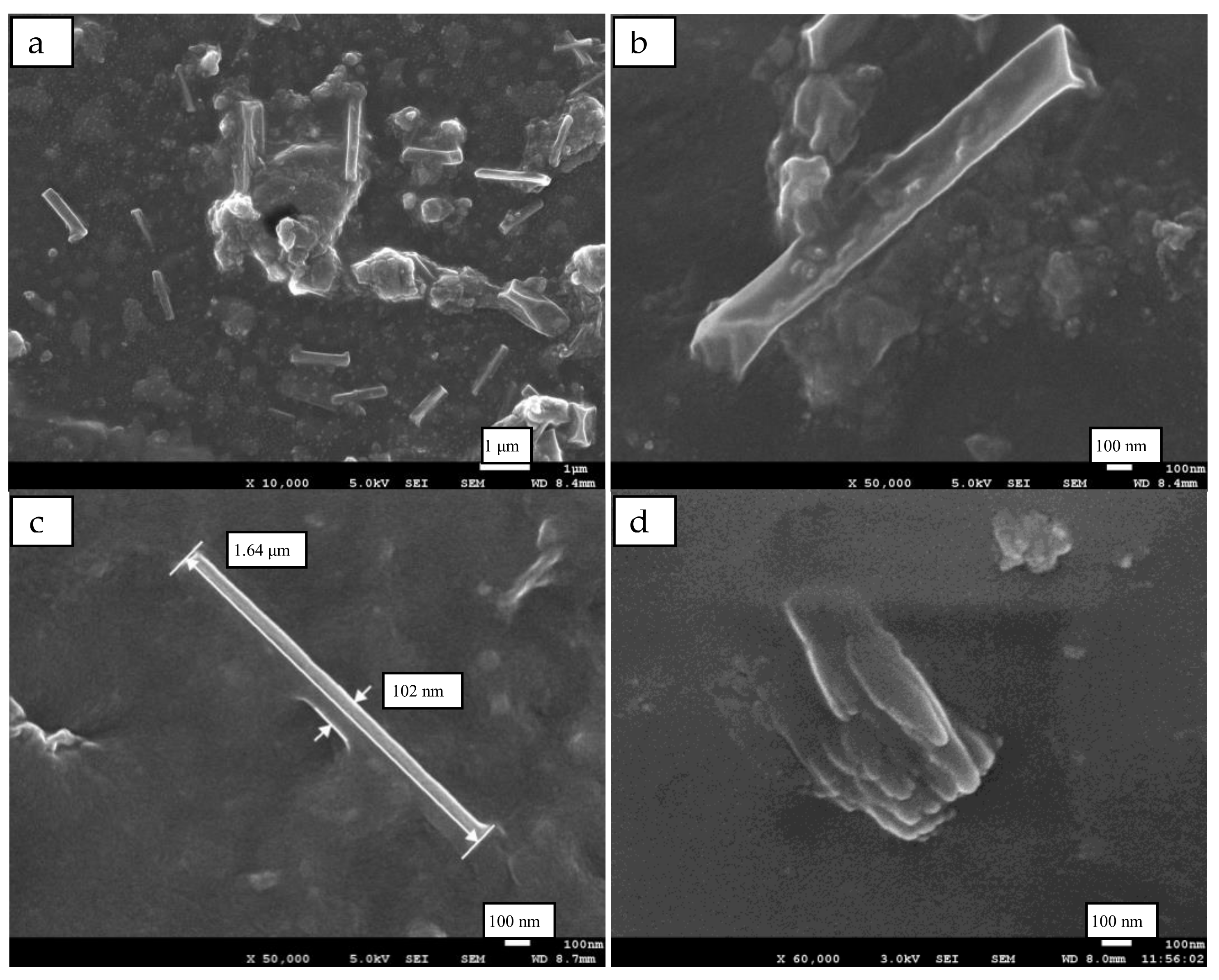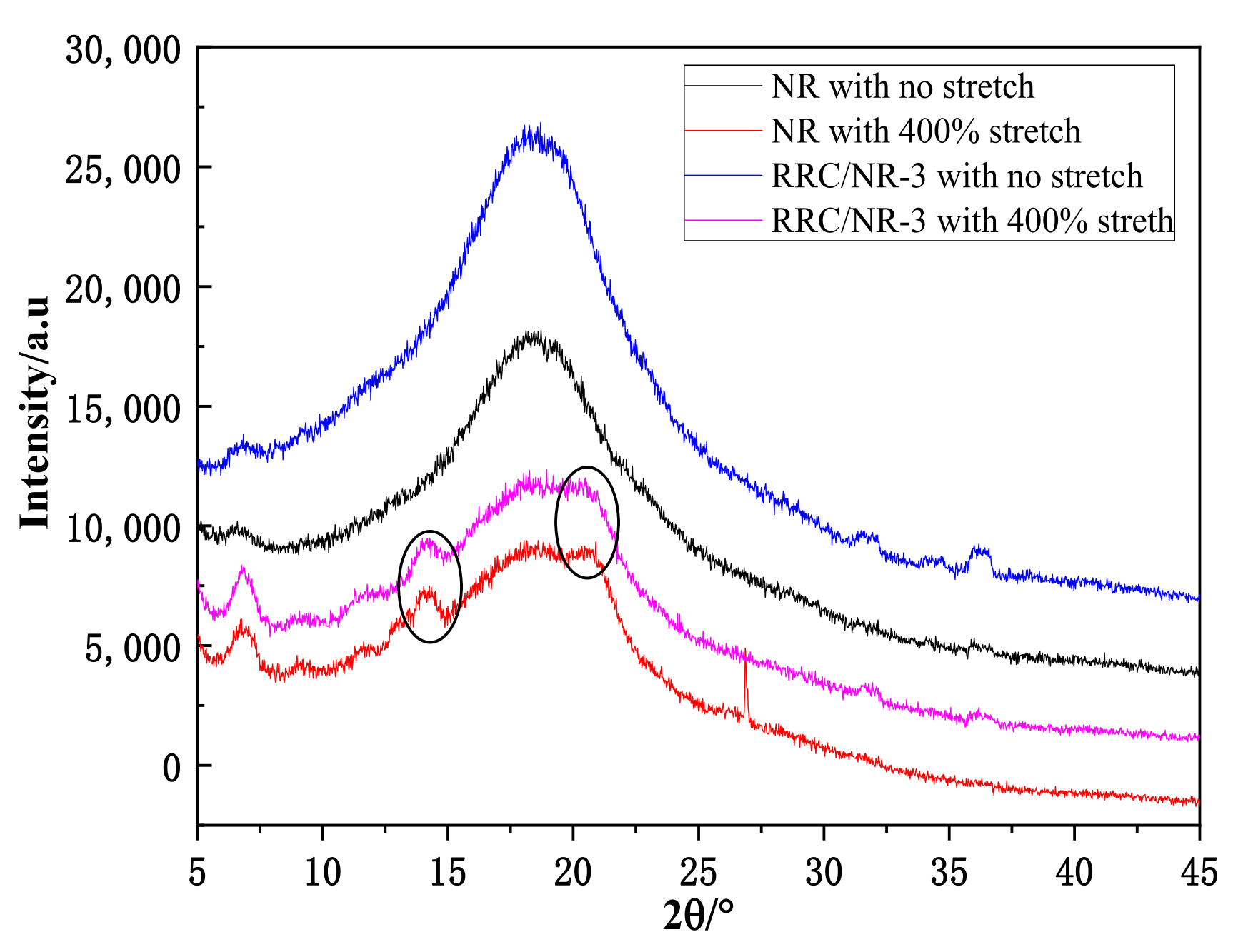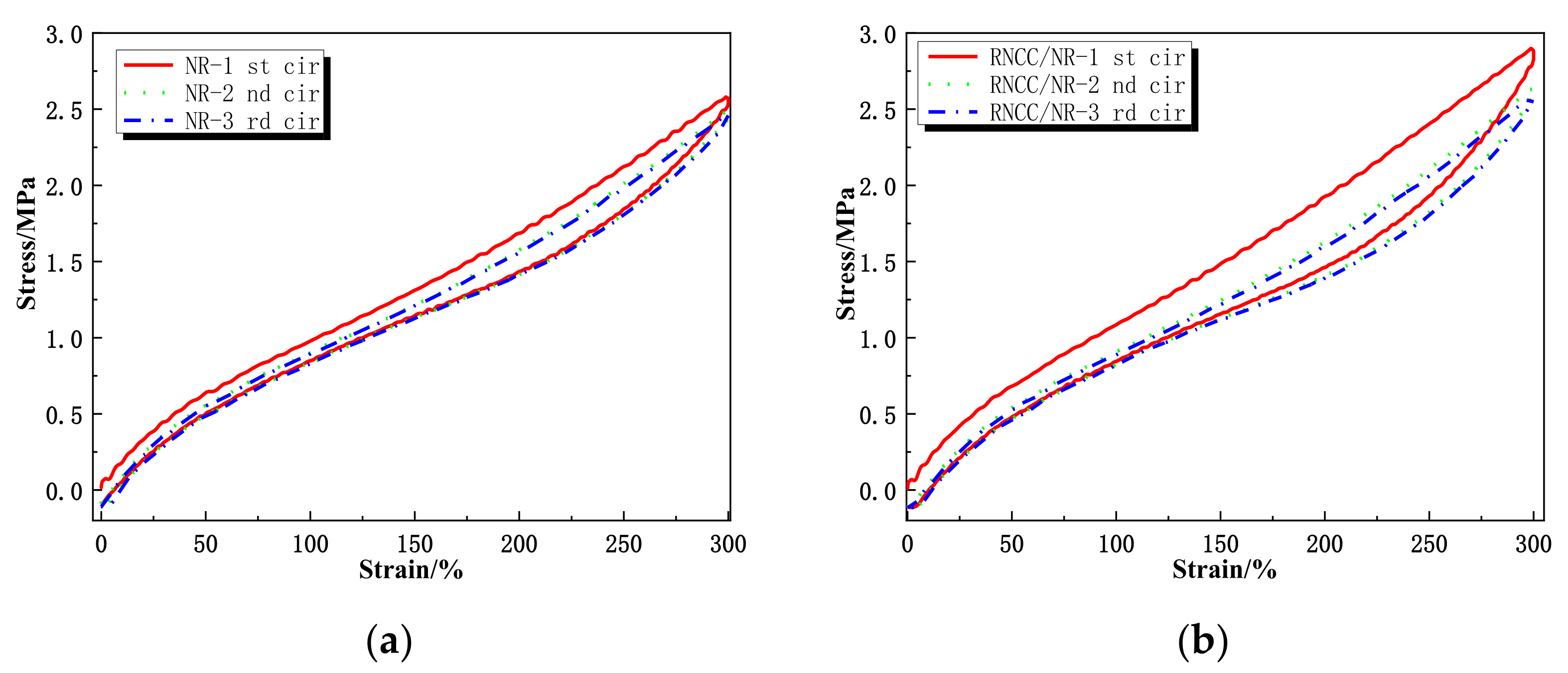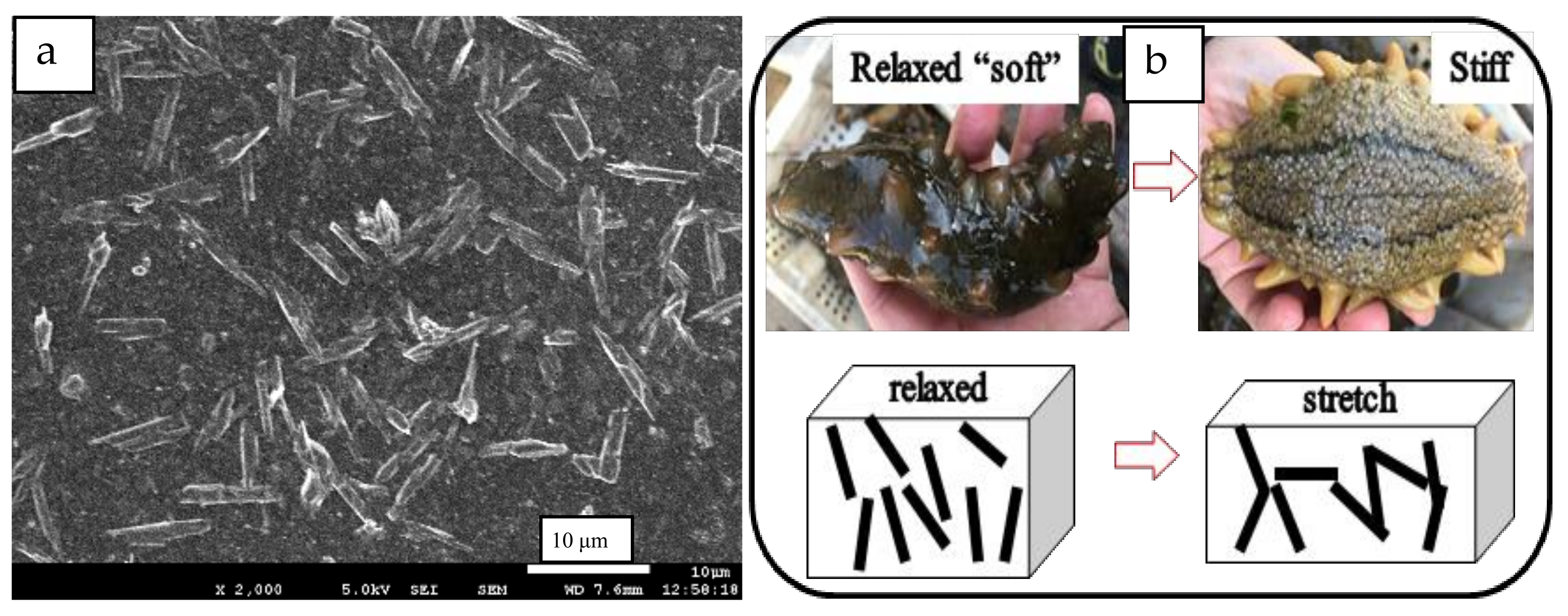Rod-like Cellulose Regenerated by Bottom-Up Assembly in Natural Rubber Latex and Its Reinforcement
Abstract
:1. Introduction
2. Results
2.1. Micromorphologies of MCC and RC/NR Hybrids
2.2. Mechanical Properties of RC/NR Vulcanizates
2.3. Micromorphologies of Rod-like RC Particles
2.4. Mechanical Properties of RRC/NR Vulcanizates
3. Discussion
3.1. Micromorphologies of RC Particles and Their Reinforcement
3.2. Mechanical Properties of RRC/NR Vulcanizates
4. Materials and Methods
4.1. Materials
4.2. Preparation of RRC/NR Hybrids
4.3. Preparation of the Rubber Compounds
4.4. Characterization
4.4.1. Mechanical Properties
4.4.2. X-ray Diffraction (XRD)
4.4.3. Scanning Electron Microscopy (SEM)
5. Conclusions
Author Contributions
Funding
Institutional Review Board Statement
Informed Consent Statement
Data Availability Statement
Conflicts of Interest
References
- Liang, Y.H.; Liu, X.L.; Wang, L.L.; Sun, J.T. The fabrication of microcrystalline cellulose-nanoZnO hybrid composites and their application in rubber compounds. Carbohyd. Polym. 2017, 169, 324–331. [Google Scholar] [CrossRef] [PubMed]
- Correia, C.A.; Valera, T.S. Cellulose nanocrystals and jute fiber-reinforced natural rubber composites: Cure characteristics and mechanical properties. Mater. Res. 2019, 22, e20190192. [Google Scholar] [CrossRef]
- Almashhadani, A.Q.; Leh, C.P.; Chan, S.-Y.; Lee, C.Y. Nanocrystalline cellulose isolation via acid hydrolysis from non-woody biomass: Importance of hydrolysis parameters. Carbohyd. Polym. 2022, 286, 119285. [Google Scholar] [CrossRef]
- Chen, X.Q.; Deng, X.Y.; Shen, W.H.; Jiang, L.L. Controlled enzymolysis preparation of nanocrystalline cellulose from pretreated cotton fibers. Bioresources 2012, 7, 4237–4248. [Google Scholar]
- Samir, M.A.S.A.; Alloin, F.; Sanchez, J.Y.; Dufresne, A. Cross-linked nanocomposite polymer electrolytes reinforced with cellulose whiskers. Macromolecules 2004, 37, 4839–4844. [Google Scholar] [CrossRef]
- Zakharov, A.G.; Voronova, M.I.; Surov, O.V.; Rubleva, N.V.; Afineevskii, A.V. Morphology and strength characteristics of composites based on nanocrystalline cellulose and water-soluble polymers. Fiber Chem. 2018, 50, 288–292. [Google Scholar] [CrossRef]
- Cordero, A.I.; Amalvy, J.I.; Fortunati, E.; Kenny, J.M.; Chiacchiarelli, L.M. The role of nanocrystalline cellulose on the microstructure of foamed castor-oil polyurethane nanocomposites. Carbohyd. Polym. 2015, 134, 110–118. [Google Scholar] [CrossRef]
- Bai, W.; Li, K. Partial replacement of silica with microcrystalline cellulose in rubber composites. Compos. Part A Appl. Sci. Manuf. 2009, 40, 1597–1605. [Google Scholar] [CrossRef]
- Jiang, W.H.; Shen, P.Y.; Yi, J.L.; Li, L.; Wu, C.J.; Gu, J. Surface modification of nanocrystalline cellulose and its application in natural rubber composites. J. Appl. Polym. Sci. 2020, 137, e49163. [Google Scholar] [CrossRef]
- Ramirez, J.A.A.; Fortunati, E.; Kenny, J.M.; Torre, L.; Foresti, M.L. Simple citric acid-catalyzed surface esterification of cellulose nanocrystals. Carbohyd. Polym. 2017, 157, 1358–1364. [Google Scholar] [CrossRef]
- Liu, H.; Pang, B.; Tang, Q.Y.; Muller, M.; Zhang, H.; Dervisoglu, R.; Zhang, K. Self-assembly of surface-acylated cellulose nanowhiskers and graphene oxide for multiresponsive janus-like films with time-dependent dry-state structures. Small 2020, 16, 2004922. [Google Scholar] [CrossRef]
- Liu, H.; Pang, B.; Garces, R.; Dervisoglu, R.; Chen, L.Q.; Andreas, L.; Zhang, K. Helical fibers via evaporation-driven self-assembly of surface-acylated cellulose nanowhiskers. Angew. Chem. 2018, 130, 16561–16566. [Google Scholar] [CrossRef] [Green Version]
- Pang, B.; Liu, H.; Liu, P.W.; Peng, X.W.; Zhang, K. Water-in-oil Pickering emulsions stabilized by stearoylated microcrystalline cellulose. J. Colloid Interface Sci. 2018, 513, 629–637. [Google Scholar] [CrossRef]
- Wang, L.; Hu, J.; Liu, Y.X.; Shu, J. Ionic liquids grafted cellulose nanocrystals for high strength and toughness PVA nanocomposite. ACS Appl. Mater. Interfaces 2020, 12, 38796–38804. [Google Scholar] [CrossRef]
- Abraham, E.; Deepa, B.; Pothan, L.A.; John, M.; Narine, S.S.; Thomas, S.; Anandjiwala, R. Physicomechanical properties of nanocomposites based on cellulose nanofibre and natural rubber latex. Cellulose 2020, 20, 417–427. [Google Scholar] [CrossRef]
- Cai, J.; Zhang, L. Rapid dissolution of cellulose in LiOH/urea and NaOH/urea aqueous solutions. Macromol. Biosci. 2005, 5, 539–548. [Google Scholar] [CrossRef]
- Yan, L.F.; Gao, Z.J. Dissolving of cellulose in PEG/NaOH aqueous solution. Cellulose 2008, 15, 789–796. [Google Scholar] [CrossRef]
- Yang, Q.L.; Lue, A.; Zhang, L.N. Reinforcement of ramie fibers on regenerated cellulose films. Compos. Sci. Technol. 2010, 70, 2319–2324. [Google Scholar] [CrossRef]
- Wang, S.; Lu, A.; Zhang, L.N. Recent advances in regenerated cellulose materials. Prog. Polym. Sci. 2016, 53, 169–206. [Google Scholar] [CrossRef]
- Yu, P.; He, H.; Luo, Y.F.; Jia, D.M.; Dufresne, A. Reinforcement of natural rubber: The use of in situ regenerated cellulose from alkaline-urea-aqueous system. Macromolecular 2017, 50, 7211–7221. [Google Scholar] [CrossRef]
- Yu, P.; He, H.; Dufresne, A. A novel interpenetrating polymer network of natural rubber/regenerated cellulose made by simple co-precipitation. Mater. Lett. 2017, 205, 202–205. [Google Scholar] [CrossRef]
- Chen, P.Z.; Zhao, J.Y.; Lin, Y.F.; Chang, J.R.; Meng, L.P. In situ characterization of strain-induced crystallization of natural rubber by synchrotron radiation wide-angle X-ray diffraction: Construction of a crystal network at low temperatures. Soft Matter 2019, 15, 734–743. [Google Scholar] [CrossRef] [PubMed]
- Albouy, P.A.; Sotta, P.; Auriemma, F.; Alfonso, G.C.; DeRosa, C. Strain-induced crystallization in natural rubber. Adv. Polym. Sci. 2017, 277, 167–205. [Google Scholar]
- Julie, D.N.; Bruno, F.; Pierre, G. A review on the Mullins effect. Eur. Polym. J. 2009, 45, 601–612. [Google Scholar]
- Kobayashi, Y.; Akama, S.; Ohori, S.; Kawai, M.; Mitsumata, T. Magnetic elastomers with smart variable elasticity mimetic to sea cucumber. Biomimetics 2019, 4, 68. [Google Scholar] [CrossRef] [PubMed] [Green Version]
- Qian, C.; Asoh, T.; Uyama, H. Sea cucumber mimicking bacterial cellulose composite hydrogel with ionic strength-sensitive. Chem. Commun. 2018, 54, 11320–11323. [Google Scholar] [CrossRef] [PubMed]
- Qi, H.; Yang, Q.; Zhang, L.; Liebert, T.; Heinze, T. The dissolution of cellulose in NaOH-based aqueous system by two step process. Cellulose 2011, 18, 237–245. [Google Scholar] [CrossRef]








| Ingredients | Control | RC/NR Composties |
|---|---|---|
| Loading/phr 1 | Loading/phr | |
| NR | 100 | 0 |
| RC/NR | 0 | 100 |
| stearic acid | 2 | 2 |
| zinc oxide | 3 | 3 |
| sulfur | 2.5 | 2.5 |
| TBBS 2 | 1 | 1 |
| Coagulants | Tensile Strength (MPa) | Tear Strength (kN/m) | 300% Modulus (Mpa) | Elongation at Break (%) |
|---|---|---|---|---|
| ethanol | 22.6 | 33.0 | 2.2 | 698 |
| 5 wt% CaCl2 | 23.0 | 32.6 | 2.1 | 682 |
| glacial acetic acid | 24.2 | 36.1 | 7.4 | 563 |
| control | 22.4 | 32.1 | 2.1 | 742 |
Disclaimer/Publisher’s Note: The statements, opinions and data contained in all publications are solely those of the individual author(s) and contributor(s) and not of MDPI and/or the editor(s). MDPI and/or the editor(s) disclaim responsibility for any injury to people or property resulting from any ideas, methods, instructions or products referred to in the content. |
© 2023 by the authors. Licensee MDPI, Basel, Switzerland. This article is an open access article distributed under the terms and conditions of the Creative Commons Attribution (CC BY) license (https://creativecommons.org/licenses/by/4.0/).
Share and Cite
Yuan, H.; Li, P.; Wang, X.; Zhao, H.; Sun, J. Rod-like Cellulose Regenerated by Bottom-Up Assembly in Natural Rubber Latex and Its Reinforcement. Int. J. Mol. Sci. 2023, 24, 6457. https://doi.org/10.3390/ijms24076457
Yuan H, Li P, Wang X, Zhao H, Sun J. Rod-like Cellulose Regenerated by Bottom-Up Assembly in Natural Rubber Latex and Its Reinforcement. International Journal of Molecular Sciences. 2023; 24(7):6457. https://doi.org/10.3390/ijms24076457
Chicago/Turabian StyleYuan, Haoze, Peixing Li, Xinyu Wang, Hongying Zhao, and Jutao Sun. 2023. "Rod-like Cellulose Regenerated by Bottom-Up Assembly in Natural Rubber Latex and Its Reinforcement" International Journal of Molecular Sciences 24, no. 7: 6457. https://doi.org/10.3390/ijms24076457





